Close-up filters: shoot macro photography without a macro lens
Want a lightweight, low-cost way of shooting macro-style pictures? A close-up filter may be just what you're after
Watch the video on how to use close-up filters
There are lots of ways in which you can get your camera closer to the subject, so that small areas look big in the image. The most common solution is to use a macro lens, though obviously this requires buying a new lens – and having another bulky thing to carry around with you, just in case.
A less expensive, and less bulky, solution is a close-up filter, also known as a close-up lens. This attaches to the front of an existing lens, and works in the same way as a magnifying glass or a pair of reading glasses. This type of filter is available for most square filter systems, such as Cokin, but round screw types are more common.
Close-up filters are available in different strengths, measured in diopters; the higher the number, the higher the magnification and the closer the minimum focus of the lens becomes.
• 10 things you need to know about camera filters!
These lenses are often sold in sets with a +1, +2 and +4 diopter lens in a convenient carry case. Two or more filters can be combined to increase magnification – you just add the diopter values together to get the resulting magnification (a +2 filter used with a +4 diopter gives you a +6 diopter set-up, for example).
The optical quality of these filters is not as high as a macro lens; you tend to get more softening at the edges and more color fringing. However, they are more than capable of giving you a different view of a miniature world. They can record shots of stamps, coins and jewelry, for instance, but can also be used for artistic shots that show texture and detail that more distant shots fail to show.
The best camera deals, reviews, product advice, and unmissable photography news, direct to your inbox!
With a close-up filter, your focusing range becomes very limited (you can no longer focus on distant subjects). You can still use autofocus, however, and as there is no light loss, automatic exposure also works perfectly.
01 Magnifying glass for your lens

A close-up lens screws into the filter thread of your lens (or slots into your square filter holder). The effect of the magnification is much greater with a telephoto zoom than it is with a standard one, so a focal length of over 100mm is recommended – and one of 200mm is ideal.
02 Buy the set
The three lenses you get in close-up sets can be combined to give you more than just three levels of magnification. The cost of a set increases with its diameter; we used a 72mm set from Kood, though other manufacturers include Polaroid, Hoya, Tiffen and B+W.
• The best close-up filter sets
03 Zoom in for maximum effect
Picking the right filter, or combination of filters, to get the crop that you want is usually a matter of trial and error. The focus range with the filter in place is limited to a few inches at best, and the minimum focusing decreases as the number of diopters applied increases.
04 Focus in on the detail
As with all close-ups, depth of field gets more limited the closer you get to the subject and can be as little as a couple of millimeters. Use a tripod for stability and, if you need to ensure as much of the image is as sharp as possible, keep the camera perpendicular to the face of the subject.
More videos:
Photography tips and techniques videos
Focus stacking: how to get amazing depth of field in macro photography
How to use extension tubes for low cost-macro photography

Chris George has worked on Digital Camera World since its launch in 2017. He has been writing about photography, mobile phones, video making and technology for over 30 years – and has edited numerous magazines including PhotoPlus, N-Photo, Digital Camera, Video Camera, and Professional Photography.
His first serious camera was the iconic Olympus OM10, with which he won the title of Young Photographer of the Year - long before the advent of autofocus and memory cards. Today he uses a Sony A7 IV, alongside his old Nikon D800 and his iPhone 15 Pro Max.
He is the author of a number of books including The Book of Digital Photography, which has been translated into a dozen different languages.
In addition to his expertise in photography and videomaking, he has written about technology for countless publications and websites including The Sunday Times Magazine, The Daily Telegraph, What Cellphone, T3 and Techradar.




